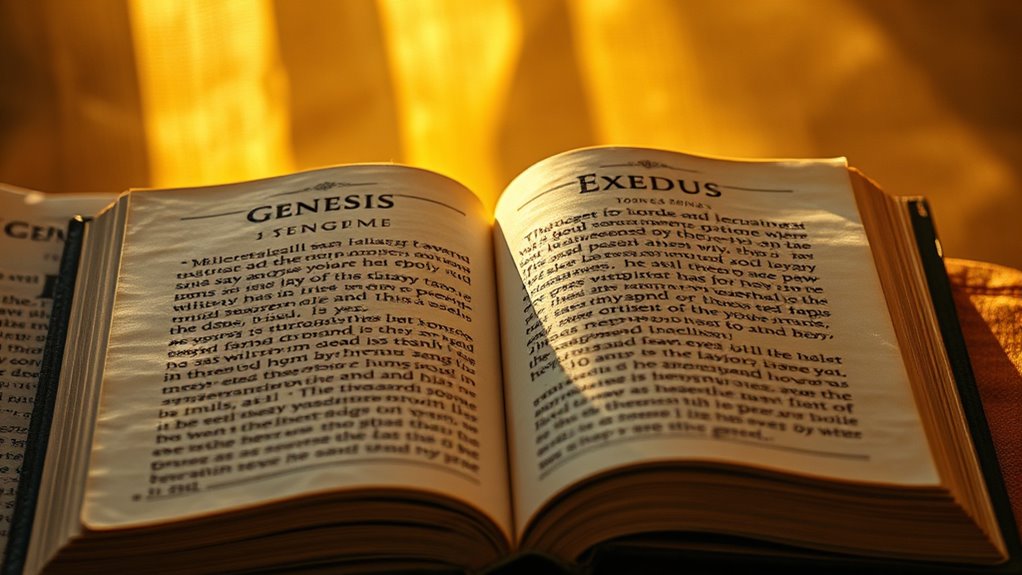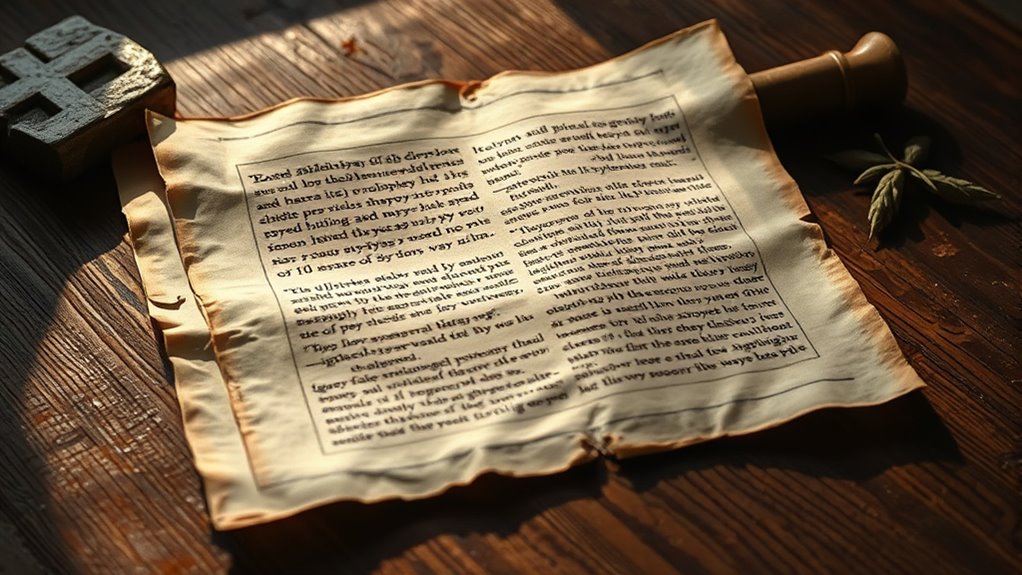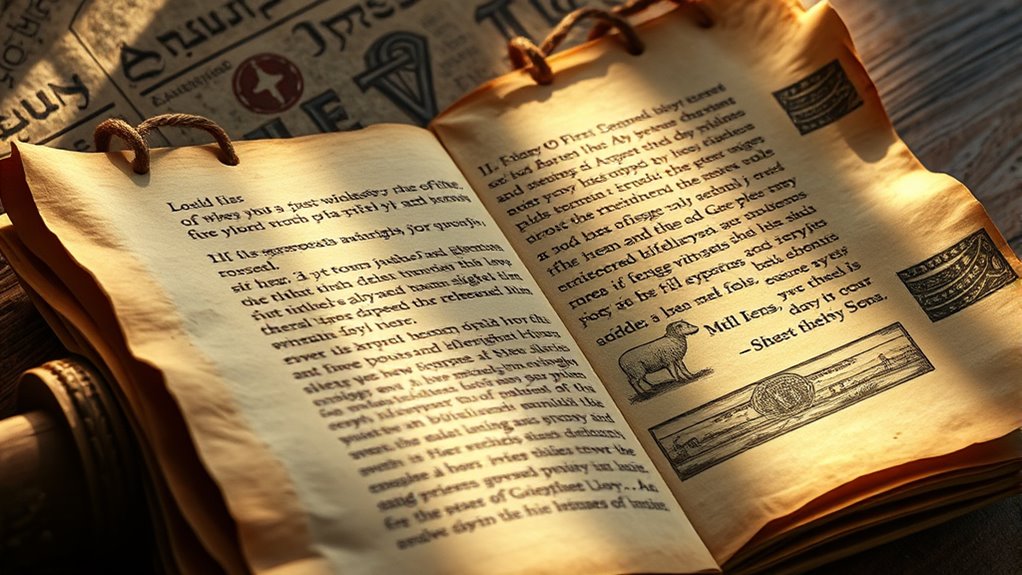The Old Covenant contains many prophecies that point to Jesus as the Messiah. You’ll see promises in Genesis and Exodus about a Savior who will bless all nations, while Isaiah describes a suffering servant who bears sins and brings salvation. Micah predicts a birth in Bethlehem, and Daniel foresees an eternal divine reign. The Psalms portray a righteous ruler with compassion. Exploring these prophecies reveals God’s plan, which reaches fulfillment in Jesus, and there’s more to uncover.
Key Takeaways
- Messianic prophecies in Genesis and Exodus foreshadow Jesus through covenant promises and rituals symbolizing salvation.
- Isaiah’s Servant songs depict a suffering figure who bears sins, prefiguring Jesus’ sacrifice and divine purpose.
- Micah predicts the Messiah’s birth in Bethlehem, fulfilling Jesus’ humble origins and divine plan.
- Daniel’s visions foretell a divine king establishing an everlasting kingdom, pointing to Jesus’ eternal reign.
- The Psalms portray the Messiah as a righteous ruler, suffering servant, and compassionate leader, aligning with Jesus’ life and mission.
Messianic Prophecies in Genesis and Exodus

In the book of Genesis and Exodus, you can find early hints of the Messiah’s coming embedded in the narrative and promises. Covenant promises play a central role, highlighting God’s commitment to send a Savior. For example, in Genesis, God establishes a covenant with Abraham, promising that through his offspring, all nations will be blessed—a clear prophecy of Christ. Similarly, covenant rituals, such as the sealing of God’s promises with sacrifices and ceremonies, foreshadow the ultimate sacrifice of Jesus. These rituals symbolize the faithfulness of God’s promise and prepare you for the coming Messiah. Together, the covenant promises and rituals in Genesis and Exodus point forward to Jesus, confirming God’s plan for salvation from the very beginning.
The Suffering Servant in Isaiah

The Suffering Servant in Isaiah vividly portrays a figure who endures pain and rejection to bring salvation, offering a powerful foreshadowing of Jesus Christ. Through prophetic symbolism, Isaiah’s Servant songs describe a humble, suffering figure who bears our sins and affliction. These songs reveal a deep spiritual meaning, highlighting that the Servant’s suffering serves a divine purpose. You see this in passages like Isaiah 52:13–53:12, where the Servant is described as despised and rejected, yet ultimately victorious through suffering. These prophetic symbols point toward a Messiah who would willingly endure hardship for humanity’s sake. The Servant songs stand as a profound Old Testament prophecy, emphasizing that true salvation involves sacrifice, foreshadowing Jesus’ life, death, and resurrection.
The Ruler From Bethlehem in Micah

Isaiah’s depiction of the suffering servant highlights a figure who endures pain to bring salvation, but the Old Testament also points to a different kind of messianic figure—one rooted in prophecy about a ruler born in Bethlehem. The Bethlehem prophecy, found in Micah’s oracle, emphasizes that the Messiah would come from this small town, fulfilling God’s plan. This prophecy underscores the significance of Bethlehem as the birthplace of this future king.
- Emphasizes the Messiah’s humble origins
- Connects to the Davidic line
- Highlights divine orchestration
- Confirms the Messiah’s birthplace
- Reinforces the fulfillment of prophecy
This prophecy assures you that Jesus’ birth in Bethlehem aligns perfectly with Micah’s oracle, fulfilling God’s promise.
The Victory and Reign Predicted in Daniel

Daniel’s visions reveal a future where God’s anointed king will establish everlasting dominion, symbolizing divine victory over earthly kingdoms. You see, this ruler will exercise true royal authority, not limited by human power but rooted in divine sovereignty. The visions depict a succession of kingdoms that will be ultimately replaced by God’s everlasting kingdom, emphasizing the triumph of divine authority over worldly realms. This victorious reign will be characterized by justice, peace, and eternal rule, highlighting the divine plan for history’s culmination. As you study Daniel, you recognize that this predicted victory points to a divine king who will overthrow oppressive regimes and establish a kingdom that lasts forever, fulfilling God’s promise of eternal dominion through His anointed.
The Psalmist’s Portrait of the Messiah

The psalmist vividly portrays the Messiah as a righteous ruler who embodies justice, mercy, and divine authority, providing a powerful contrast to earthly kings. Through Messianic symbolism and Psalmic imagery, you see a leader who cares deeply for justice and salvation. The imagery highlights qualities like humility, suffering, and divine protection, emphasizing the Messiah’s unique role. Key themes include:
The Messiah embodies justice, mercy, humility, and divine authority, contrasting earthly kings with a compassionate, divine ruler.
- The shepherd who cares for his flock
- The stone rejected by builders
- The suffering servant who bears pain
- The righteous judge who establishes justice
- The divine king reigning forever
These symbols and poetic images reveal a Messiah who combines authority with compassion, fulfilling God’s divine plan and offering hope beyond mere earthly power.
Frequently Asked Questions
How Do Old Testament Prophecies Specifically Connect to Jesus’ Life?
You see, Old testament prophecies connect to Jesus’ life through prophetic symbolism and messianic expectations. These scriptures foreshadowed His birth, suffering, and kingship, fulfilling ancient promises. You notice details like the prophecy of a suffering servant or a king from David’s line, which align with Jesus’ life events. This connection deepens your understanding of His divine mission, showing how prophecy and history intertwine to reveal God’s plan.
Are All Messianic Prophecies Fulfilled in Jesus’ First Coming?
Imagine the Bible as a blueprint; not all Messianic expectations are fulfilled in Jesus’ first coming. While many prophecies, like His birth and death, align with Old Testament prophecy fulfillment, some remain unfulfilled, hinting at His second coming. So, not all Messianic prophecies are realized now. You should see His first arrival as a partial fulfillment, with future prophecy still awaiting fulfillment.
What Is the Historical Context Behind These Prophetic Writings?
You should understand that these prophetic writings emerged within ancient political and cultural influences that shaped their messages. As you explore the historical context, you’ll see how the prophets responded to events like exile, oppression, and shifting empires. These circumstances motivated their visions of hope and redemption, reflecting the struggles and aspirations of their people, which later influenced interpretations linking these prophecies to broader messianic expectations.
How Do These Prophecies Influence Christian Faith Today?
These prophecies offer faith encouragement by reaffirming God’s promises and His plan for salvation. They hold doctrinal significance, shaping core beliefs and inspiring trust in God’s sovereignty. As you explore these writings, you’re reminded of divine faithfulness, strengthening your spiritual journey. Believing in these fulfilled prophecies helps you find hope and reassurance, deepening your connection to God’s ongoing plan and encouraging you to live out your faith with confidence.
Are There Any Conflicting Interpretations of These Messianic Prophecies?
The landscape of interpretative debates about messianic prophecies is a battleground where different views clash like thunderclaps. You’ll find theological disagreements that cast shadows of doubt, with some seeing Jesus as the fulfillment while others see only symbolism or different figures. These conflicting interpretations can shake your faith but also deepen your understanding, reminding you that faith often journeys through storms of doubt toward clearer light.
Conclusion
You can’t ignore how these prophecies scream across history, boldly declaring Jesus’ arrival with the power of a thunderclap. They paint a picture so vivid, it’s as if the ancient words leap off the pages and into your life, transforming doubt into unwavering faith. These divine predictions are like a cosmic spotlight, shining brighter and clearer than anything else, proving beyond all doubt that Jesus was truly God’s ultimate plan—written in the stars long before time began.










